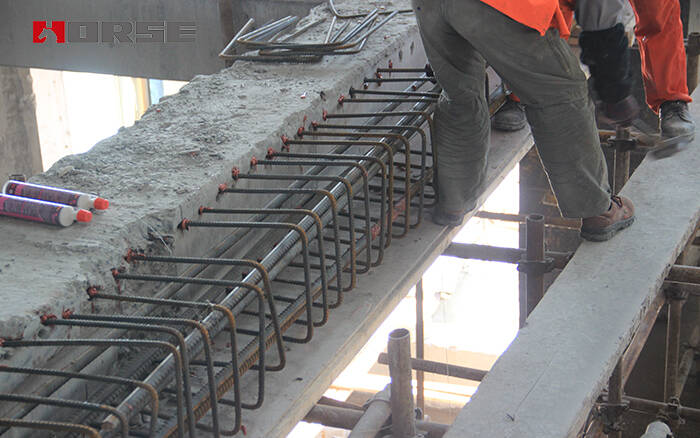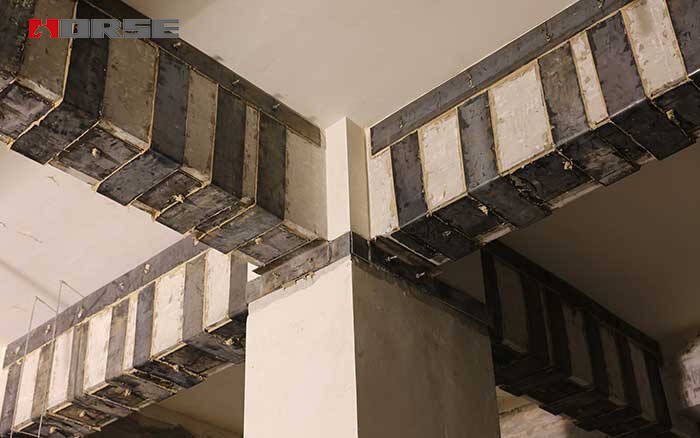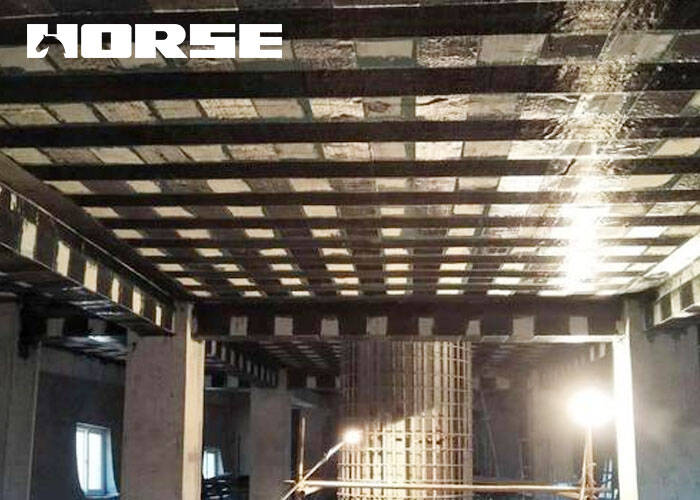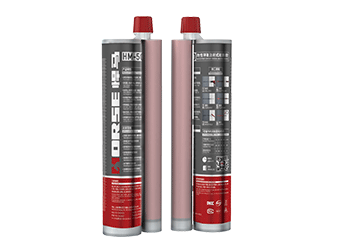Solutions
Horse Construction offers full range of structural strengthening materials with technical supports, documentation supports, products supports, project supports.
How To Strengthen The Frame Structure?
Frame structure is one of the most frequently used structural forms of multi-storey buildings, which is favored by structural engineers because of its clear and simple force transmission.
However, most of the early houses in my country were not fortified against earthquakes, which also resulted in the existence of many reinforced concrete frame structures without seismic fortifications. The beam-column joints of such buildings without seismic fortification are generally defective in structure, and there are fewer hoops in the core area of the joints, which greatly reduces the seismic capacity of the structure. In order to ensure the safety of the building, the building is reinforced at this time to improve the integrity of the frame.
Before carrying out the reinforcement construction, it is important to analyze the failure mode of the frame structure. We all know that in the frame structure, the wall is not load-bearing, but only plays the role of enclosure and isolation. The column is the main load-bearing component, bearing the additional load caused by the vertical load and horizontal force of the entire structure. The common failure forms of frame columns mainly include the following:
Bending failure
Bending failure is a common failure form of frame columns in earthquakes, which mainly occurs when the column shear span is relatively large, the axial compression is relatively small and the reinforcement is reasonable. This situation is controlled by the flexural capacity.
The main failure modes are: the plastic hinge area at the top or bottom of the column is completely cracked horizontally, the longitudinal bars yield, and the concrete is obviously crushed and peeled off when the final failure occurs. The whole process absorbs large seismic energy, which belongs to ductile failure.
Shear failure
Shear failure is a failure method to be avoided in the seismic design of frame columns, which mainly occurs when the shear span is relatively small, the axial pressure is relatively large, and the concrete strength or stirrup restraint is insufficient. This situation is controlled by the shear bearing capacity. When the stirrups fail, the longitudinal bars never yield. After the shear bearing capacity is reached, the horizontal force borne by the column decreases rapidly with the increase of the deformation.
The main failure modes are: the concrete exhibits obvious shear slip, and the brittle shear failure occurs rapidly after the oblique crack. According to the specific failure form, it can be divided into shear compression failure, shear tension failure, and shear cable-pull failure.
Bending shear failure
Bending shear failure is between bending failure and shear failure. Due to the limitation of various objective conditions, the occurrence of shear failure cannot be completely avoided in the actual design, so the deformation capacity of the structure should be strictly controlled in the design. The characteristic of bending-shear failure is that as the deformation increases, the longitudinal bars of the column yield first, and plastic hinges appear at the end of the column. Due to the development of shear diagonal cracks, the effective shear area of concrete decreases, and the aggregate occlusal force decreases. After a period of plastic deformation, the shear bearing capacity of the column decreases with the increase of deformation. As the deformation continues to increase, the stirrups in the plastic hinge zone yield, and the column undergoes shear failure. At this time, the concrete at the compression edge does not reach the ultimate compressive strain.
The failure process mainly includes longitudinal reinforcement yielding, concrete cover spalling, reinforcement exposure, stirrup yielding, and longitudinal reinforcement buckling. Before bending-shear failure, the member presents a relatively stable bending response, showing a certain ductility and energy dissipation capacity.
In addition, the longitudinal bars of many reinforced concrete columns built in the early days are not connected and are provided with lap joints. Under the action of earthquake, when the lap length is insufficient and the effective restraint provided by the stirrup is insufficient, the lap joint is prone to bond failure, which affects the seismic performance of the column. If you want to improve the seismic performance of the frame column, it is necessary to start with the above failure mechanisms to improve the bearing capacity and deformation capacity of the column. At present, the most widely used methods are enlarging section reinforcement method, outsourcing steel reinforcement method, pasting steel plate reinforcement method, carbon fiber reinforcement method and so on.

Enlarging section reinforcement method
The cross-section reinforcement method is to increase the cross-sectional area of the reinforced concrete member and configure quantitative stirrups in the newly added concrete to improve its bearing capacity.
The reinforcement mechanism is to increase the shear area of the core area of the node. The newly added part of the area directly participates in the shear resistance, and at the same time, it has a certain restraint effect on the concrete in the core area of the original node, which improves the shear strength and stiffness of the node, inhibits the development of cracks, and reduces the shear deformation at the node.
In addition, after the section of the node is increased, the anchorage length of the beam longitudinal reinforcement at the node is relatively increased, which effectively improves the bonding performance between the beam longitudinal reinforcement and the concrete in the core area of the node. Moreover, the brittle failure due to the failure of the bond and anchorage of the beam longitudinal reinforcement is avoided.
Outsourcing steel reinforcement method
Outsourcing steel reinforcement method, the reinforcement method is divided into two types: dry type and wet type. There is no bond between the original component and the section steel in the dry-type outer steel method, and there is no overall force transmission between the two. The wet outsourcing steel method fills the original component and the section steel with a binder such as epoxy resin or latex cement, so that the two materials have a good ability to work together. It is suitable for structures that need to greatly increase the bearing capacity without excessively increasing the size of the concrete section.
The frame joints reinforced with out-wrapped profiled steel usually refer to the four or two corners of the reinforced concrete components covered with profiled steel, and the outer profiled steel is connected as a whole with transverse slats or slats to form a steel frame that is closely connected with the wrapped components. The outer steel has a constraining effect on the core area of the node, which limits the development of cracks and greatly improves the ultimate bearing capacity of the concrete in the core area. After reinforcement, the section steel and the original concrete members are jointly stressed.

Bonding steel plate reinforcement method
The bonding steel reinforcement method is to bond the steel plate with structural adhesive on the surface of the concrete member and anchor it with bolts, and strengthen the member through the joint force of the two materials.
The mechanism of reinforcing beams and columns by bonding steel method is to directly provide shear bearing capacity through the pasted steel plates, and at the same time provide constraints on the concrete in the core area, delay the development of cracks in the core area, and enhance the bonding and anchoring of beam longitudinal bars in the core area. In this way, the stiffness and shear strength of the joint group are increased, thereby improving the seismic capacity of the joint.

Carbon fiber reinforcement
Carbon fiber cloth reinforcement technology (carbon cloth reinforcement technology) is to use special structural adhesive to paste carbon fiber cloth on the surface of concrete to form a composite structure. CFRP works collaboratively with concrete to strengthen components or structures and improve mechanical performance .
The carbon fiber reinforcement method can effectively improve the axial compression bearing capacity, inclined section bearing capacity and displacement ductility of frame columns. The frame column is reinforced with carbon fiber cloth, which has the least disturbance to the original structure, basically does not increase the weight and does not affect the shape of the structure.
You can find anything here you are in need of, have a trust trying on these products, you will find the big difference after that.

High strength, unidirectional carbon fiber wrap pre-saturated to form a carbon fiber reinforced polymer (CFRP) wrap used to strengthen structural concrete elements.

High strength carbon fiber reinforced polymer (CFRP) strip / laminate / plate for structural strengthening and concrete repair

two-components modified epoxy resin adhesive, with high quality plastic tube, double cartridge package